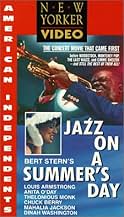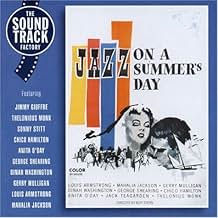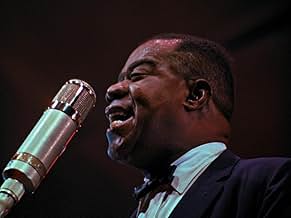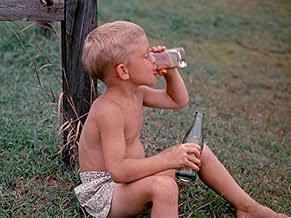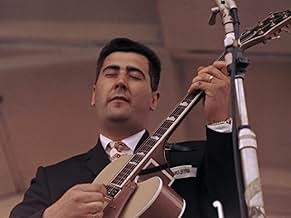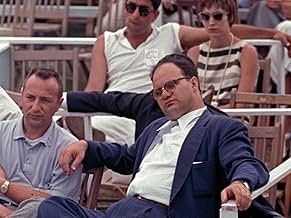PUNTUACIÓN EN IMDb
7,9/10
2,1 mil
TU PUNTUACIÓN
Lo más destacado del Festival de Jazz de Newport de 1958.Lo más destacado del Festival de Jazz de Newport de 1958.Lo más destacado del Festival de Jazz de Newport de 1958.
- Dirección
- Guión
- Reparto principal
- Premios
- 2 premios en total
Reseñas destacadas
A treasure to savor is JAZZ ON A SUMMER'S DAY is a concert/documentary of the 1958 jazz festival at Newport, RI. It captures a time and a sound, a mood of America that's now only a fairly distant memory. Interspersed with the music are shots of the Americas Cup trials, some shots of Newport etc. But the focus is the music and the stars. Louis Armstrong, Dinah Washington, Anita O'Day, Gerry Mulligan, Thelonius Monk, Mahalia Jackson, Chico Hamilton, and Jack Teagarden. And in a nod to more contemporary stuff (and a portent to the end of cool jazz), Chuck Berry also sings. There's also Big Maybelle, who I never heard of. It's all cool and relaxing and the audience seems happy and well dressed. Dig those crew cuts and all those people smoking!
While the photography and sound are a little primitive, they don't detract from the stars. Armstrong and Teagarden do their "Rockin; Chair" duet, Washington sings "All of Me," O'Day scorches "Sweet Georgia Brown" Monk plays "Blue Monk" on piano. There's also an impossibly young Mulligan wailing on his sax, and Jackson in a moving set of songs.
The audience is fascinating. Society matrons amid the hipster fans. Smoking, drinking, dancing. Kids and adults. It was a time when music still spoke to a universal audience. Shots of kids enthralled by Chico Hamilton's hypnotic drum set. Smiling faces enjoying the music and patter of Armstrong and Teagarden.
Within a few years, the famed Newport Jazz Festival would be geared more for rock and roll, screaming crowds, and higher decibels. That's exactly what makes this 1958 outing such a cool treat.
While the photography and sound are a little primitive, they don't detract from the stars. Armstrong and Teagarden do their "Rockin; Chair" duet, Washington sings "All of Me," O'Day scorches "Sweet Georgia Brown" Monk plays "Blue Monk" on piano. There's also an impossibly young Mulligan wailing on his sax, and Jackson in a moving set of songs.
The audience is fascinating. Society matrons amid the hipster fans. Smoking, drinking, dancing. Kids and adults. It was a time when music still spoke to a universal audience. Shots of kids enthralled by Chico Hamilton's hypnotic drum set. Smiling faces enjoying the music and patter of Armstrong and Teagarden.
Within a few years, the famed Newport Jazz Festival would be geared more for rock and roll, screaming crowds, and higher decibels. That's exactly what makes this 1958 outing such a cool treat.
This is a wonderful document of the 1958 Newport Jazz Festival and archetype for the concert film, with captivating interludes of visual poetry. As close as one can get to traveling back through time, watching the audience is as much fun here as watching the performers. You can recognize this film as a source of inspiration, perhaps, for the pretensions behind projects like "The Last Waltz," and one certainly gets a sense, given the caliber of the performers gathered onto a single stage, of the magnitude of this event without it ever being forced. The intimacy remains intact. And in contrast with the somber beat of "The Last Waltz," the sun shines on everything here. A joy.
I think you can enjoy this film on a few levels.
First, it's a great chronicle of mid-century music. Although nominally a jazz festival, producer George Wein put Berry, a rock 'n roll star, and Jackson, the leading gospel singer of her day, on the roster, probably to attract a larger crowd.
The images are superb. If you're over 50, you probably recall Bert Stern's photography. It was a pinnacle of mid-century advertising (the Smirnoff ad shot in the Egyptian desert with the pyramid, inverted, in a refreshingly cool vodka martini glass with a twist). It was his stills of Sue Lyons in Stanley Kubrick's version of Lolita that everyone remembers. Almost everyone has seen his iconic nude photo shoot of Marilyn Monroe ("The Last Sitting").
Here you have the still photographer's sensibility brought to a documentary. You can see the same thing in Ken Burns' earlier works for the same reason. The tight shots of the performers using very long lenses (something that was not yet common in film but was emerging on TV at the time). The long, languid, at times voyeuristic shots of the audience. The Festival was taking place at the same time as the America's Cup trials. Stern shot some of this from a Piper Cub (inexpensive to rent and almost as slow as a helicopter), and there are some long cutaways to this footage. At times, the images on the screen resemble the LP covers of the era the original "Miles Ahead" cover, for example, featuring the beautiful (white) model on a sailboat (which Davis despised).
The mono sound is surprisingly good given the circumstances, probably because the audio track was engineered and recorded by Columbia Records, which was there to record its artists. They used then-state-of-the-art studio microphones rather than the more durable lower quality ones you'd typically see in a concert setting in those days. Yes, sound recording technology is better today.
Second, you can appreciate the back story of making the film. Today, people in their 20s and 30s making documentaries probably have no appreciation of how tough it was to pull off this project. Today, high definition video cameras and tape can be had for a tiny fraction of what film cameras, 35MM stock and processing cost in those days. Sound synchronization is a given. Today, for a fraction of the cost of a Moviola you can assemble your A and B rolls and soundtrack on a computer, without having to pay extras for optical effects or sound processing. You no longer have to assemble and keep track of miles of film and mag stripe audio reels, as well as handle the negative with loving care. It's all there on your hard drive and you get unlimited do-overs. Aram Avakian, the editor (also a photographer and filmmaker), was at it night and day for months and months largely by himself. (Woodstock, by contrast, had a large team of editors and assistants.) Avakian, as much as Stern, is responsible for the film (the two share the director's credit). Also, trying to sync up the images from all those different cameras with the soundtrack had to be challenging and I'm guessing it must have required a lot of work and inspired work-arounds to get it looking as good as it did.
Not to mention just how audacious it was for Stern to put the money up for shooting it himself and how he managed to get a large number of professional cameramen to help out. Since he didn't have enough money to shoot (or even light) everything, Stern used George Avakian, a legendary producer at Columbia Records and Aram's brother, to cue the film crew to turn on the lights and start rolling when he thought a number would be worth shooting.
After scouting the location, Stern was so unimpressed by the Festival's cruddy venue (the local high school athletic field) he decided not to make the film, only to have his mind changed by the person sitting next to him on his flight back to New York. He originally planned to create a story line around the festival. Luckily, it proved impossible to film the hokey stuff they had written.
Third, it's an authentic look at mid-century America. When I was growing up in the 60s, I used to look at back issues of Life magazines of the 30s and 40s. At first to "goof on" at the earnestness and corniness of the ads and the stories. But then to appreciate the nuances of living everyday life in the decades before I was born, which you could glean from leafing through those pages. "Anonymous history" is infused in the film. The kid holding several empty soda bottles is probably there at the festival because sneaking into an event like this and picking up empties was an easy way to earn some money. In those days, the deposit you paid on bottles was much larger in real terms than today.
Shows like "Mad Men" do a decent enough job of picking up some of the atmospherics of this time (usually by showing people smoking cigarettes like madmen), but this is the real thing. The clothes, especially, but also in the gestures and the way people move. And then there's the White/Negro thing in this film. There wasn't the kind of overt racism in Newport, Rhode Island that you would find in the south but there was definitely separateness. Remember, in 1958 Amos 'n Andy was still being shown on TV, and only white people were in TV ads. The two groups are integrated in the movie, but this wasn't typical. Stern was told that he probably couldn't distribute the movie in the south because of this.
In all, a real gem for anyone who loves jazz. A must-see for anyone who likes, makes or wants to make documentary films.
First, it's a great chronicle of mid-century music. Although nominally a jazz festival, producer George Wein put Berry, a rock 'n roll star, and Jackson, the leading gospel singer of her day, on the roster, probably to attract a larger crowd.
The images are superb. If you're over 50, you probably recall Bert Stern's photography. It was a pinnacle of mid-century advertising (the Smirnoff ad shot in the Egyptian desert with the pyramid, inverted, in a refreshingly cool vodka martini glass with a twist). It was his stills of Sue Lyons in Stanley Kubrick's version of Lolita that everyone remembers. Almost everyone has seen his iconic nude photo shoot of Marilyn Monroe ("The Last Sitting").
Here you have the still photographer's sensibility brought to a documentary. You can see the same thing in Ken Burns' earlier works for the same reason. The tight shots of the performers using very long lenses (something that was not yet common in film but was emerging on TV at the time). The long, languid, at times voyeuristic shots of the audience. The Festival was taking place at the same time as the America's Cup trials. Stern shot some of this from a Piper Cub (inexpensive to rent and almost as slow as a helicopter), and there are some long cutaways to this footage. At times, the images on the screen resemble the LP covers of the era the original "Miles Ahead" cover, for example, featuring the beautiful (white) model on a sailboat (which Davis despised).
The mono sound is surprisingly good given the circumstances, probably because the audio track was engineered and recorded by Columbia Records, which was there to record its artists. They used then-state-of-the-art studio microphones rather than the more durable lower quality ones you'd typically see in a concert setting in those days. Yes, sound recording technology is better today.
Second, you can appreciate the back story of making the film. Today, people in their 20s and 30s making documentaries probably have no appreciation of how tough it was to pull off this project. Today, high definition video cameras and tape can be had for a tiny fraction of what film cameras, 35MM stock and processing cost in those days. Sound synchronization is a given. Today, for a fraction of the cost of a Moviola you can assemble your A and B rolls and soundtrack on a computer, without having to pay extras for optical effects or sound processing. You no longer have to assemble and keep track of miles of film and mag stripe audio reels, as well as handle the negative with loving care. It's all there on your hard drive and you get unlimited do-overs. Aram Avakian, the editor (also a photographer and filmmaker), was at it night and day for months and months largely by himself. (Woodstock, by contrast, had a large team of editors and assistants.) Avakian, as much as Stern, is responsible for the film (the two share the director's credit). Also, trying to sync up the images from all those different cameras with the soundtrack had to be challenging and I'm guessing it must have required a lot of work and inspired work-arounds to get it looking as good as it did.
Not to mention just how audacious it was for Stern to put the money up for shooting it himself and how he managed to get a large number of professional cameramen to help out. Since he didn't have enough money to shoot (or even light) everything, Stern used George Avakian, a legendary producer at Columbia Records and Aram's brother, to cue the film crew to turn on the lights and start rolling when he thought a number would be worth shooting.
After scouting the location, Stern was so unimpressed by the Festival's cruddy venue (the local high school athletic field) he decided not to make the film, only to have his mind changed by the person sitting next to him on his flight back to New York. He originally planned to create a story line around the festival. Luckily, it proved impossible to film the hokey stuff they had written.
Third, it's an authentic look at mid-century America. When I was growing up in the 60s, I used to look at back issues of Life magazines of the 30s and 40s. At first to "goof on" at the earnestness and corniness of the ads and the stories. But then to appreciate the nuances of living everyday life in the decades before I was born, which you could glean from leafing through those pages. "Anonymous history" is infused in the film. The kid holding several empty soda bottles is probably there at the festival because sneaking into an event like this and picking up empties was an easy way to earn some money. In those days, the deposit you paid on bottles was much larger in real terms than today.
Shows like "Mad Men" do a decent enough job of picking up some of the atmospherics of this time (usually by showing people smoking cigarettes like madmen), but this is the real thing. The clothes, especially, but also in the gestures and the way people move. And then there's the White/Negro thing in this film. There wasn't the kind of overt racism in Newport, Rhode Island that you would find in the south but there was definitely separateness. Remember, in 1958 Amos 'n Andy was still being shown on TV, and only white people were in TV ads. The two groups are integrated in the movie, but this wasn't typical. Stern was told that he probably couldn't distribute the movie in the south because of this.
In all, a real gem for anyone who loves jazz. A must-see for anyone who likes, makes or wants to make documentary films.
Partly a jazz concert and partly a time capsule to a long ago era, "Jazz On A Summer's Day" records highlights of the four-day, 1958 festival held in Newport, Rhode Island. The film gets off to a slow start, with interviews of arriving audience, shots of Newport, and cutaways to the America's Cup yacht race, taking place concurrently.
About nine minutes into the film, the real program begins. The brilliant Thelonious Monk plays "Blue Monk" on the keys. From here on, most of the audio and visuals focus on the festival itself, except for brief visual cuts to the sailing event and impromptu shots of people enjoying themselves in presumably nearby locales. Although the film title says "day", about two-thirds of the film is shot at night.
Different styles of jazz provide ample variety, and run the gamut from an apparently unrelated boarding house jam session to the rockin', soul-stirring gospel music of Mahalia Jackson, who forcefully belts out three numbers at the end. Louis Armstrong and rarely filmed trombone legend Jack Teagarden perform a casual, seemingly improv vocal of "Old Rocking Chair". Dinah Washington singing "All Of Me", and the unusual percussion sounds of the Chico Hamilton Quintet are also quite good. But my personal favorite was Chuck Berry and band with a slowed down, beat thumpin' rendition of "Sweet Little Sixteen".
My only serious complaint is the film's editing, which includes the sailing event and quite a few extraneous visuals, and a too-brief overall runtime. A three-hour total jazz event would have been ideal.
The overall mood of the concert is upbeat, almost carnivalesque. The camera jumps back and forth between on-stage performers and audience reaction. Everyone seems to be having a good time. Glad to see this film recognized by the National Film Registry, to preserve an account of a unique event, held at a crucial moment in American history.
About nine minutes into the film, the real program begins. The brilliant Thelonious Monk plays "Blue Monk" on the keys. From here on, most of the audio and visuals focus on the festival itself, except for brief visual cuts to the sailing event and impromptu shots of people enjoying themselves in presumably nearby locales. Although the film title says "day", about two-thirds of the film is shot at night.
Different styles of jazz provide ample variety, and run the gamut from an apparently unrelated boarding house jam session to the rockin', soul-stirring gospel music of Mahalia Jackson, who forcefully belts out three numbers at the end. Louis Armstrong and rarely filmed trombone legend Jack Teagarden perform a casual, seemingly improv vocal of "Old Rocking Chair". Dinah Washington singing "All Of Me", and the unusual percussion sounds of the Chico Hamilton Quintet are also quite good. But my personal favorite was Chuck Berry and band with a slowed down, beat thumpin' rendition of "Sweet Little Sixteen".
My only serious complaint is the film's editing, which includes the sailing event and quite a few extraneous visuals, and a too-brief overall runtime. A three-hour total jazz event would have been ideal.
The overall mood of the concert is upbeat, almost carnivalesque. The camera jumps back and forth between on-stage performers and audience reaction. Everyone seems to be having a good time. Glad to see this film recognized by the National Film Registry, to preserve an account of a unique event, held at a crucial moment in American history.
Not quite a concert film, not quite a travelogue, this "day and night in the life" of the Newport Jazz Festival is a delight. Some standout performances, including an unforgettable rendition of Sweet Georgia Brown by Anita O'Day and a gorgeous set by a beatific Mahalia Jackson would make this film worth watching all on their own. But, there's more. A very young Chuck Berry makes an appearance, and the earliest Rock and Roll seems boring by comparison to the many styles of jazz displayed in this film. Despite the repetitive groove, the folks in the audience can't help moving their feet to it and the future is foretold. Bert Stern deliberately moves the focus away from Berry's stage pyrotechnics and keeps it on the audience and the amused if bored jazz musicians. Did he know this was what the future held? Maybe. Bits and pieces of the lives of affluent Newport residents, a yacht race (America's Cup qualifying), jazz musicians practicing, a break into Bach by a cellist, dancing on the rooftops, all the small parts that make this film greater than their sum, this is one worth watching, and perhaps, like me, you'll find it one worth adding to your permanent library of musical film.
¿Sabías que...?
- CuriosidadesIn Hilton Als' 2008 New Yorker review of the documentary Anita O'Day: The Life of a Jazz Singer (2007), Als reports that Anita O'Day was high on heroin during her performance at the 1958 Newport Jazz Festival, and she was unaware that her performance was filmed until later. O'Day spoke frankly about her struggles with heroin addiction in her 1981 autobiography.
- Citas
Louis Armstrong: I was at a little Italian trumpet player's house, and his mother was a Countess, well they was makin' that spaghetti and we was wailin', you know. In this big ol' dinin' room they had this table and up in the ceilin' they had Mark Anthony and Cleo and all the cats that they painted. Lookin' down on you as if to say, "Man, you shore can eat!"
[laughs]
Louis Armstrong: Well, we have a lot of fun travelin', man.
Selecciones populares
Inicia sesión para calificar y añadir a tu lista para recibir recomendaciones personalizadas
- How long is Jazz on a Summer's Day?Con tecnología de Alexa
Detalles
- Fecha de lanzamiento
- País de origen
- Idioma
- Títulos en diferentes países
- Festival de jazz
- Localizaciones del rodaje
- Empresas productoras
- Ver más compañías en los créditos en IMDbPro
Taquilla
- Recaudación en todo el mundo
- 74.811 US$
Contribuir a esta página
Sugerir un cambio o añadir el contenido que falta





